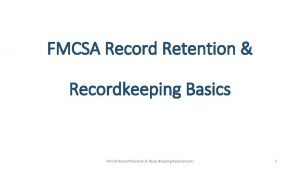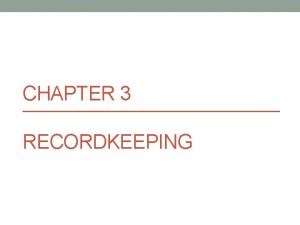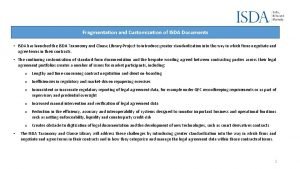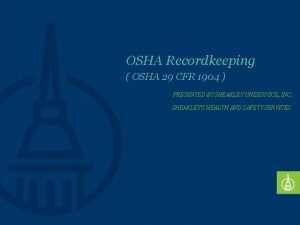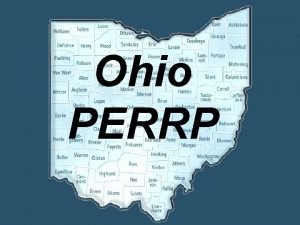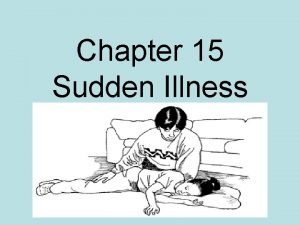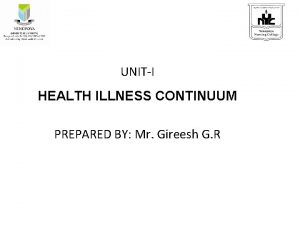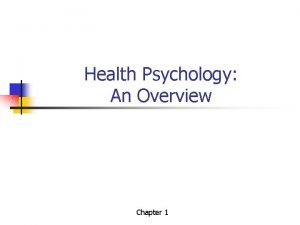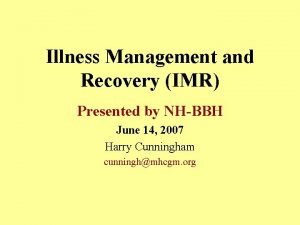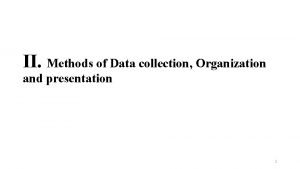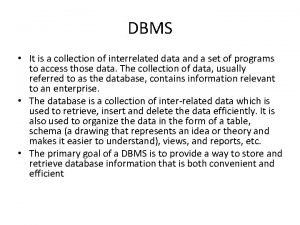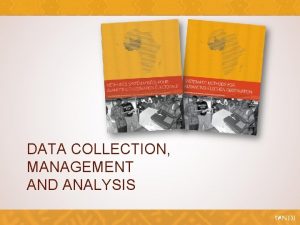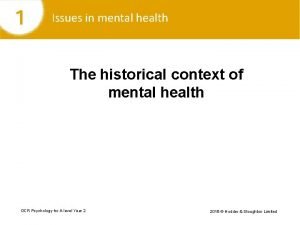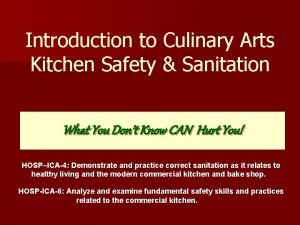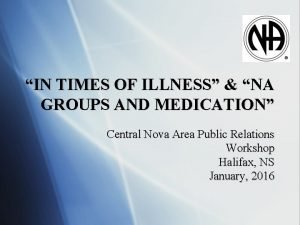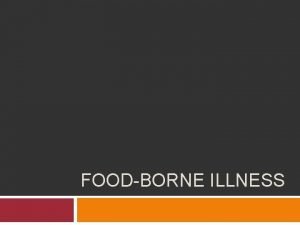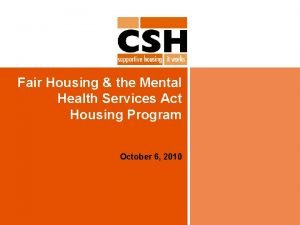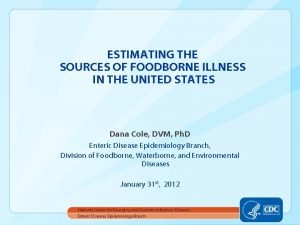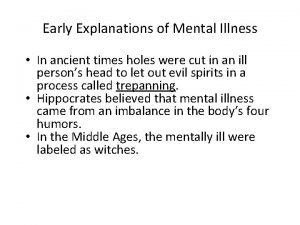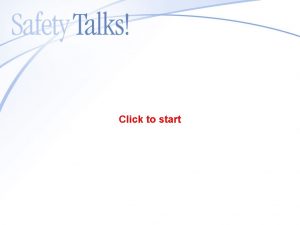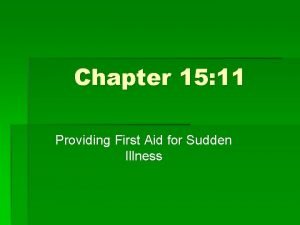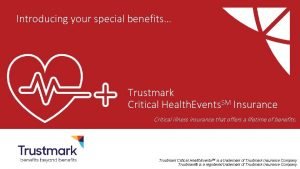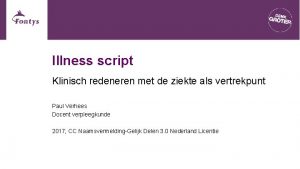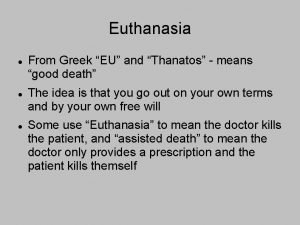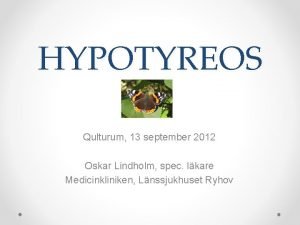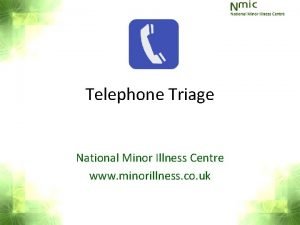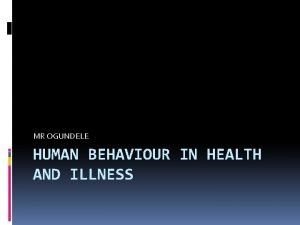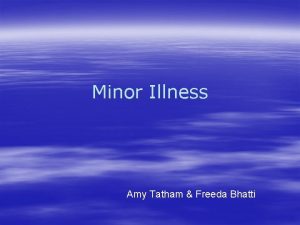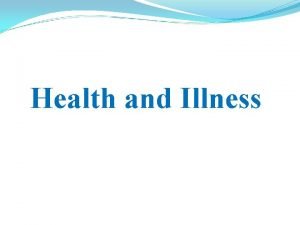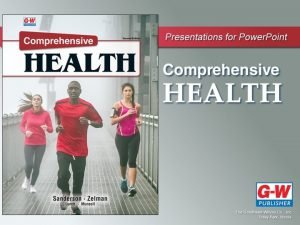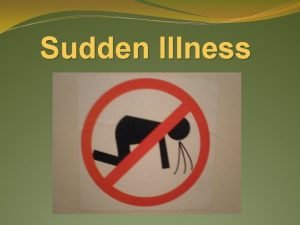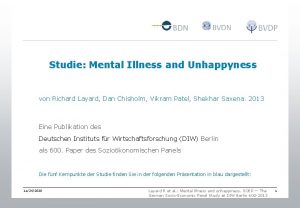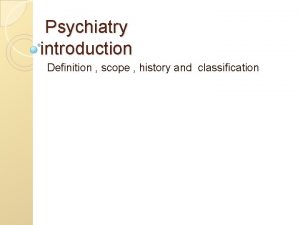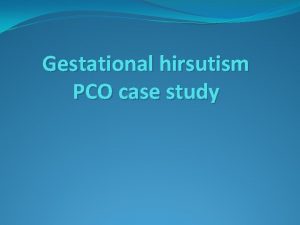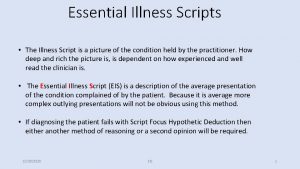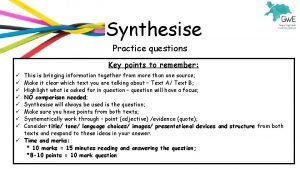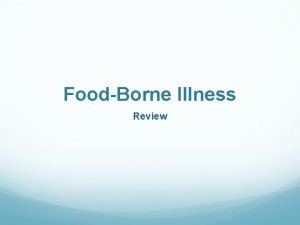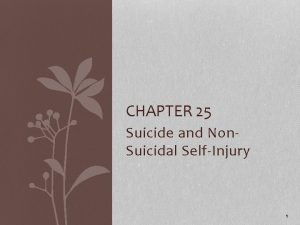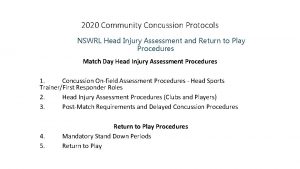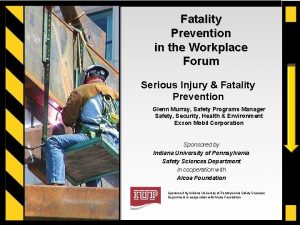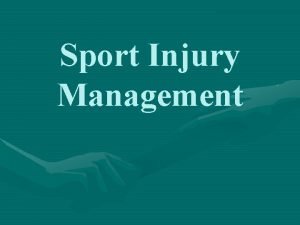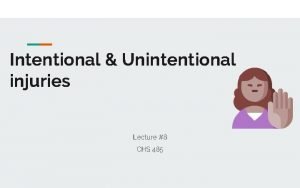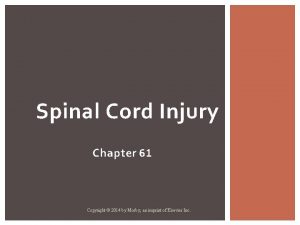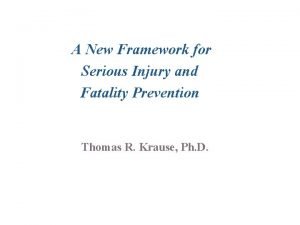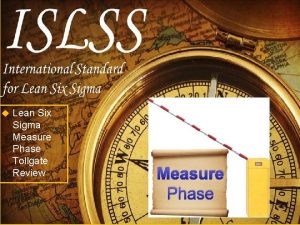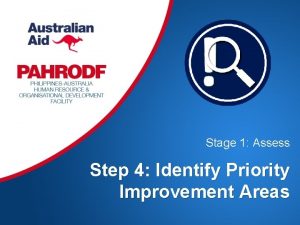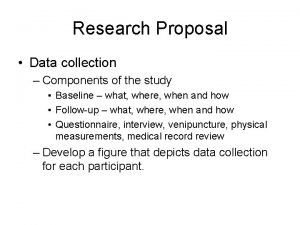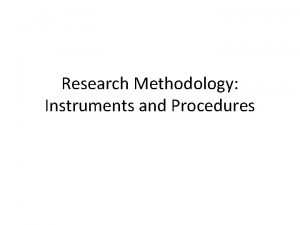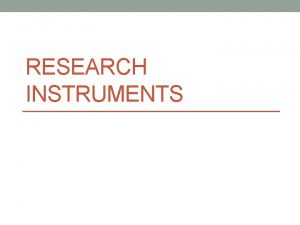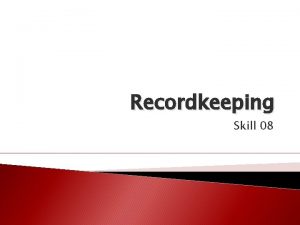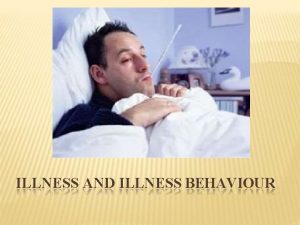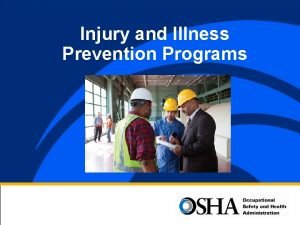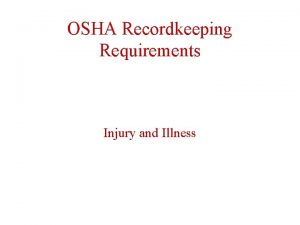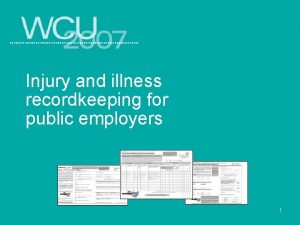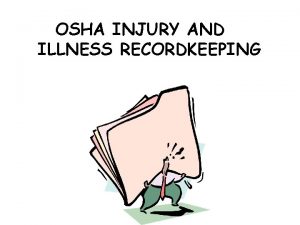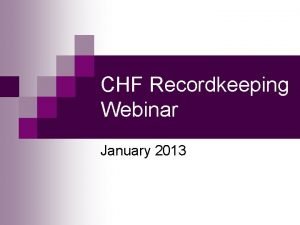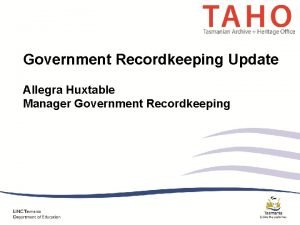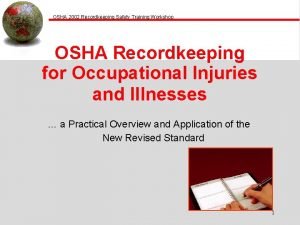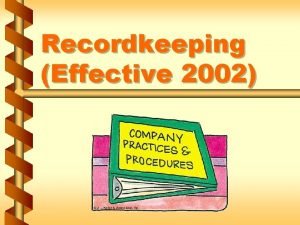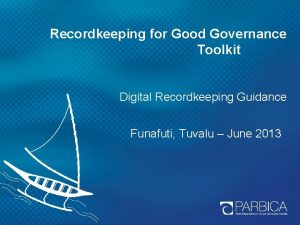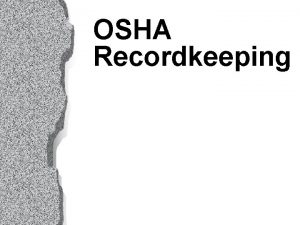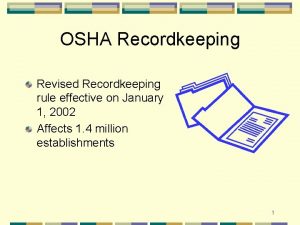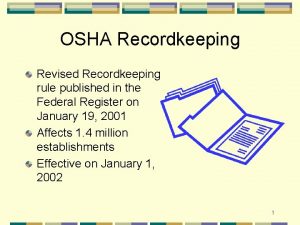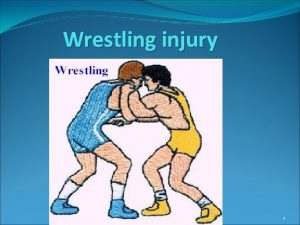PERRP Injury and Illness Recordkeeping Data collection and
























































































- Slides: 88

PERRP Injury and Illness Recordkeeping Data collection and submission requirements for public employers Troy Cale Industrial Hygienist BWC Division of Safety & Hygiene Public Employment Risk Reduction Program 1

Session overview • What are the requirements for public employer injury and illness recordkeeping in Ohio Administrative Code (OAC) 4167 -06? – Overview of the requirements • What are the changes to recordkeeping procedures? • What are the most common recordkeeping mistakes? • What are the steps to becoming an effective record keeper? 2

Purpose (of the Rule) • To develop a system of statistical data collection • Public employers in Ohio are required to record and report work-related fatalities, injuries and illnesses – Note: Recording or reporting a work-related injury, illness, or fatality does not mean the employer or employee was at fault, a PERRP rule has been violated, or that the employee is eligible for workers’ compensation or other benefits. • PERRP injury and illness recordkeeping and Bureau of Workers’ Compensation are independent of each other 3

Scope of recordkeeping • The OAC amplifies the Ohio Revised Code (ORC) and creates the details for recordkeeping. • All fundamental recordkeeping requirements are outlined in OAC 4167 -6 -01 through 04 • Public employers in Ohio are therefore required to record work-related fatalities injuries and illnesses. 4

Scope of statistical collection • The ORC creates the actual rule for statistical collection, no amplification needed. • All fundamental statistical collection requirements are outlined in ORC 4167. 11. • It requires maintenance of an effective program of collection, compilation, and analysis of employment risk reduction statistics. • Public employers in Ohio are therefore required to submit statistical information. 5

ORC 4167. 11 (B) To implement and maintain the statistics program, the workers' compensation Board of Directors is required to adopt rules that require public employers to: – “Make, keep, and preserve, and make available” necessary reports and records appropriate for standards enforcement or for developing information regarding the causes and prevention of occupational accidents and illnesses. 6

Recordkeeping vs. statistics • Two independent requirements under Chapter 4167 blended together • Less burdensome to submit recordkeeping summary instead of requiring independent statistics • Recordkeeping requirement established in 1994 • Submit summary 300 AP established in 2003 • Will allow public entities to compare injury illness data with similar entities 7

Statistical information DOES NOT: • Cause an inspection; • Cause citations or fines to be issued; • Cause a determination of compensation rates; • Determine injury, illness or fatality fault; • Determine eligibility for a compensation claim. 8

ORC 4167. 11 (B) • Public employers are also required to: – Post notices or otherwise “keep their public employees informed” of their rights and obligations; – Maintain accurate records of public employee exposure to potentially toxic materials, carcinogenic materials, and harmful physical agents. 9

Organization of the Rule • • • 6 -01: Records maintained by calendar year 6 -02: Log and Summary 6 -03: Supplementary Record 6 -04: Annual Summary 6 -05: Falsification of Records 6 -06: BWC Reporting (Reserved) 6 -07: Retention of Records 6 -08: Access to Records 6 -09: Monitoring Records 6 -10: Reporting of Fatalities and Catastrophes 10

Covered Employees • Employees on payroll • Employees of non-profit boards that are supervised by public employees (MRDD, etc. ) • Employees not on payroll who are supervised on a day-to-day basis (temporary employment) – Temporary help agencies only record their employee injuries when they are under their supervision. Injuries of temp workers who are supervised by a public employer must be recorded by the PE. • Exclude volunteers and restitution workers 11

Exemptions? ? ? As of July 2007, there are NO exemptions. Ohio Public employers must log all recordable work-related injuries and illnesses. This includes work-related injuries and illnesses involving police officers, corrections officers, firefighters, EMTs and paramedics. 12

Multiple business establishments • Employers must keep a separate log and summary for each establishment. • Establishment is defined as: – A single physical location where business is conducted; or, – Where services or industrial operations are performed. • Establishment logs can be maintained in a central location, if: – Incidents are reported to the central office within six calendar days – Updated copies of the Log are provided to each establishment quarterly. OAC 4167 -6 -02 13

Required forms • Log and summary, PERRP 300 P and 300 AP or equivalent • Supplementary, PERRP 301 P or equivalent • BWC First Report of an Injury, Occupational Disease or Death (FROI) is equivalent to 101/301. OAC 4167 -6 -02 & 4167 -6 -03 14

PERRP forms • 300 P, Log of Work-Related Injuries and Illnesses • 300 AP, Summary of Work-Related Injuries and Illnesses • 301 P, Injury and Illness Incident Report • The new forms clarify the requirements for public employers and reference the appropriate sections in the ORC/OAC. • More on the new forms later. 15

STEP 1 16

STEP 2 17

STEP 3 18

Filling out the forms You must follow the instructions! 19

What instructions? • PERRP has created a set of instructions to help public employers understand apply the recording criteria. – The PERRP instructions are similar to the Federal OSHA instructions but different. 20

WHAT DO I DO FIRST? • PERRP 301 P or equivalent • BWC First Report of Injury (FROI) is equivalent to 301 P. 21

Step 1 PERRP form 301 P 22

OK. THAT WAS NOT TOO DIFFICULT. I KNOW IT HAS TO GET HARDER. WHAT DO I DO NEXT? 23

Step 2 24

Recording criteria Public employers must record each fatality, injury or illness that: – Is work-related, and; – Is a new case, and; – Meets one or more of the recording criteria contained in the instructions. 25

General recording criteria • Requires records to include any work-related injury or illness resulting in one of the following. – – – Death Days away from work Restricted work or transfer to another job Medical treatment beyond first aid Loss of consciousness Diagnosis of a significant injury/illness by a physician or other licensed health care professional 26

Recording Criteria Decision Tree 27

Work-relatedness • Cases are work-related if: – An event or exposure in the work environment either caused or contributed to the resulting condition; – An event or exposure in the work environment significantly aggravated a pre-existing injury or illness. 28

Work-relatedness • Work-relatedness is presumed for injuries and illnesses resulting from events or exposures occurring in the work environment. • A case is presumed work-related if, and only if, an event or exposure in the work environment is a discernable cause of the injury or illness or of a significant aggravation to a pre-existing condition. • The work event or exposure need only be one of the discernable causes; it need not be the sole or predominant cause. 29

Work-related exceptions There a total of nine exceptions. 1. Commuting to and from an establishment 2. Eating, drinking or preparing food or drink for personal consumption 3. Common colds and flu 4. Voluntary participation in wellness or fitness programs 5. Personal grooming or self-medication 6. In the establishment as a member of the general public 7. Symptoms of non-work related injury/illness 8. Personal tasks not related to employment, and 9. Mental illness (unless employee provides proof of work relatedness) 30

Travel Status Any injury or illness that occurs while an employee is on travel status is workrelated if it occurred while the employee was engaged in work activities in the interest of the employer. 31

Work at Home* Injuries and illnesses that occur are workrelated if they: – occur while the employee is performing work for pay or compensation in the home, and – are directly related to the performance of work rather than the general home environment 32

Significant aggravation • A pre-existing injury or illness is significantly aggravated when an event or exposure in the work environment results in any of the following (which otherwise would not have occurred). – Death – Loss of consciousness – Days away, days restricted or job transfer – Medical treatment 33

Medical treatment • Medical treatment is the management and care of a patient to combat disease or disorder. • It does not include: – Visits to a PLHCP solely for observation or counseling; – Diagnostic procedures; – First aid. 34

First aid • Using nonprescription medication at nonprescription strength • Tetanus immunizations • Cleaning, flushing, or soaking surface wounds • Wound coverings, butterfly bandages, Steri-Strips • Hot or cold therapy • Non-rigid means of support • Temporary immobilization device used to transport accident victims 35

First aid (continued) • Drilling of fingernail or toenail, draining fluid from blister • Eye patches • Removing foreign bodies from eye by irrigation or cotton swab • Removing splinters or foreign material from areas other than the eye by irrigation, tweezers, cotton swabs or other simple means • Finger guards • Massages • Drinking fluids for relief of heat stress 36

Significant diagnosed injury or illness • The following work-related conditions must always be recorded at the time of diagnosis by a PLHCP. – Cancer – Chronic irreversible disease – Punctured eardrum – Fractured or cracked bone or tooth 37

Bloodborne Pathogens • Record all work-related needlesticks and cuts from sharp objects that are contaminated with another person’s blood or other potentially infectious material (includes human bodily fluids, tissues and organs; other materials potentially infected with HIV, HBV, or other pathogens such as laboratory cultures) • Other sharps injuries (from uncontaminated objects) would only be recordable if medical treatment beyond first aid was required. • Record splashes or other exposures to blood or other potentially infectious material if it results in diagnosis of a bloodborne disease or meets the general recording criteria 38

Hearing Loss • Starting January 1, 2004, record all work-related hearing loss cases where: – Employee has experienced a Standard Threshold Shift (STS)1, and – Employee’s total hearing level is 25 decibels (d. B) or more above audiometric zero [averaged at 2000, 3000, and 4000 hertz (Hz)] in the same ears as the STS – Determine if the case meets this criteria then record the hearing loss on the date of diagnosis. A STS is defined in OSHA’s noise standard at 29 CFR 1910. 95(g)(10)(i) as a change in hearing threshold, relative to the baseline audiogram, of an average of 10 d. B or more at 2000, 3000, and 4000 Hz in one or both ears. 1 39

Use this “decision tree” to determine whether the results of a audiometric exam given on or after January 1, 2003 reveals a recordable STS. No Has the employee suffered a STS (an average 10 d. B or more loss relative to the most current baseline audiogram averaged at 2000, 3000 and 4000 Hz) in one or both ears according to the provisions of the OSHA noise standard (1910. 95)? * Yes No Is the employee’s overall hearing level at 25 d. B or more above audiometric zero averaged at 2000, 3000 and 4000 Hz in the affected ear(s)? Yes No Is the hearing loss work-related? Yes Do not record Record on the OSHA 300 Log and check the “Hearing Loss Column” Note: In all cases, use the most current baseline to determine recordability as you would to calculate a STS under the hearing conservation provisions of the noise standard (1910. 95). If an STS occurs in only one ear, you may only revise the baseline audiogram for that ear. * The audiogram may be adjusted for presbycusis (aging) as set out of 1910. 95. 40

Musculoskeletal Disorders • Applies the same recording criteria to musculoskeletal disorders (MSDs) as to all other injuries and illnesses • Employer retains flexibility to determine whether an event or exposure in the work environment caused or contributed to the MSD 1904. 12 41

Day counts • Eliminates the term lost workdays and focuses on days away or days restricted or transferred • Includes rules for counting that rely on calendar days instead of workdays 42

Days away cases • Day counts (days away or days restricted) – Count the number of calendar days the employee was unable to work (include weekend days, holidays, vacation days, etc. ). – Cap day count at 180 days away and/or days restricted. – May stop day count if employee leaves your agency for a reason unrelated to the injury or illness. – If a medical opinion exists, employer must follow that opinion. – DO NOT count the day of the injury! 43

Employee privacy • Prohibits employers from entering an individual’s name on the Log for certain types of injuries/illnesses (enter “privacy case”) • Provides employers the right not to describe the nature of sensitive injuries where the employee’s identity would be known • Gives employee representatives access only to the portion of Incident Report which contains no personal information • Requires employers to remove employees’ names before providing the data to persons not provided access rights under the rule 44

Privacy cases • You must consider the following injuries or illnesses to be privacy concern cases. – An injury or illness to an intimate body part or the reproductive system – An injury or illness resulting from a sexual assault – Mental illnesses – HIV infection, hepatitis, or tuberculosis – Needlestick injuries and cuts from sharp objects that are contaminated with another person's blood or OPIM (see § 1910. 1030 for definitions) – Other illnesses, if the employee voluntarily requests that his or her name not be entered on the log. • This is the complete list of all injuries and illnesses considered privacy concern cases for the purposes of PERRP recordkeeping, and it is consistent with HIPAA. 45

Restricted work cases • Restricted work activity exists if the employee is: – Unable to work the full workday he or she would otherwise have been scheduled to work; or – Unable to perform one or more routine job functions. • An employee’s routine job functions are those activities the employee regularly performs at least once per week. 46

Restricted work A case is not recordable as a restricted work case if: • The employee experiences minor musculoskeletal discomfort, • A health-care professional determines that the employee is fully able to perform all of his or her routine job functions, or; • The employer assigns a work restriction to that employee for the purpose of preventing a more serious condition from developing. 47

Job Transfer • An injured or ill employee is assigned to a job other than his or her regular job for part of the day • A case is recordable if the injured or ill employee performs his or her routine job duties for part of a day and is assigned to another job for the rest of the day 1904. 7(b)(4) 48

Step 3 49

New and improved – Step 3 Changes have been made for calendar year 2007 to the PERRP 300 AP. The changes simplify the reporting requirements for public employers in Ohio. 50

Annual summary • Before completing the summary: – Review Log for completeness and accuracy, correct deficiencies – Complete summary (PERRP Form 300 AP) – Certify summary • Post summary • If you have multiple establishments (locations), create a master summary. • Submit master summary to PERRP on or before Feb. 1. 51

Master summary • Employers with multiple establishments are asked to create and submit a master summary. • So, one summary should be submitted from each of the following: – Cities, townships, school districts, special districts, villages, and most state agencies • There a few exceptions to the master summary submission. 52

Master summary exceptions • The following must submit multiple summaries – Counties, one summary for each of the following: • Commissioners, highway engineer, county home/care center, county MRDD) – Universities and colleges • One summary for each campus or branch campus and one for each medical center/hospital – ODOT • One summary for each district – ODNR • One summary for each park – ODRC • One summary for each correctional facility 53

Reporting to PERRP • All summary submissions must include the public employer’s BWC risk number. • Copies of subsequent annual summaries must be sent to PERRP by Feb. 1 of each year. – You can submit your summary by logging onto: ohiobwc. com with BWC login and password. OAC 4167 -6 -04 54

Retention and updating • Retain forms for five years following the year that they cover. • Update the Log during that period. • You do not need to update the summary or incident forms. OAC 4167 -6 -07 55

Sign here Knowingly falsifying this document may result in a fine. I certify that I have examined this document and that to the best of my knowledge the entries are true, accurate and complete. Administrator Name (Print) Title Administrator Name (Signature) Date Phone Email Address 56

Falsification and failure to maintain records or reports • A failure to post a copy of the establishment's annual summary will result in the issuance of a citation. • If a false statement, representation or certification of the required records is knowingly given, a willful failure to comply order will be issued. ORC 4167. 05 57

D A B ^ THE 7 HABITS OF HIGHLY ^ EFFECTIVE RECORDKEEPERS IN Or… Who wants to be an effective recordkeeper? 58

Bad Habit #1 • Failure to fill in the Year at the top of the 300 P Log and Summary • Prevents PERRP and the employer from measuring sequential annual incidence rates. 59

Bad Habit #2 • Over-recording of incidents on the Log – (e. g. first aid incidents, miscounting days away from work, new case in new year) • Not every incident is recordable and not every BWC compensable claim is recordable. • Over-recording creates artificially high incidence rates. • Research each case carefully and compare the facts to the recording criteria. 60

Bad Habit #3 • Failure to properly calculate total number of full-time and part-time employees • Including police, firefighters, paramedics and EMTs in your total count (these job classifications are listed separately) • Including substitutes and volunteers in your total count 61

Bad Habit #4 • Failure to maintain a Log and Summary for each establishment • This requirements helps identify specific work area concerns. • PERRP and the employer can then focus on areas of greatest concern. • This will result in a timely resolution of safety and health concerns. 62

Bad Habit #5 • Failure to certify the Summary • Certifying the Summary ensures that upper management is aware of the injury and illness trends in its establishments. • Upper management knowledge is critical in the development and prioritization of safety and health issues. • Management commitment and planning establish a firm foundation for an effective safety and health program. 63

Bad Habit #6 • Failure to post the Summary • Post the summary from Feb. 1 to April 30 every year, even if you do not have any recordable injuries (zero summary)! • Employees must be informed of the nature and frequency of workplace injuries and illnesses. • Communication is key to the success of a safety and health program. 64

Bad Habit #7 • Failure to submit the Summary • This provides the employer and PERRP with a snapshot of overall concerns in the workplace. • Helps the employer and PERRP compare incidence rates across public employment sectors. • With data from every public employer in Ohio, PERRP can concentrate on areas of concern and develop effective consultation program enhancements to prevent public employment injuries and illnesses. 65

The 7 Bad Habits 1. Failure to fill in the Year at the top of the 300 P Log and Summary 2. Over-recording of incidents on the Log 3. Failure to properly calculate total number of employees 4. Failure to maintain a Log and Summary for each establishment 5. Failure to certify the Summary 6. Failure to post the Summary 7. Failure to submit the Summary 66

Reporting needlesticks • OAC 4167 -3 -06(B) requires employers to record all needlestick and sharps injuries involving contamination by another person’s blood or other potentially infectious material. • In addition to recording, all sharps injuries must be reported to PERRP electronically or by the approved form. 67

PERRP sharps injury form 68

69

Scenario 1 Sue Wilson is a student teacher working in her classroom at Maple High School, 1100 Wheeling Ave. Cambridge, OH 43725. Sue started her workday at 7: 00 a. m. at the end of her first class at 8: 20 a. m. she trips on some books and falls on the concrete floor and is sent to the hospital where she is diagnosed with a broken wrist. Is this a recordable injury on the school district’s 300 P log? 70

Answer 1 Yes. Sue is a student teacher and although she is not an employee of the school district she is under the direction and control of the school district. Therefore her injury is recordable. Now let’s take the information we have and complete a PERRP 301 P form for Sue. 71

Scenario 2 Bob is a county employee; his headquarters is home-based. Bob is moving a file box full of work-related documents at his home office and drops the file box on his foot, breaking a toe. Is this injury recordable on his employer’s 300 P log? 72

Answer 2 Yes. PERRP considers injuries and illnesses that occur while an employee is working at home, including work in a home office, work related if the injury or illness occurs while the employee is performing work for pay or compensation in the home. 73

Scenario 3 Mike normally reports to his local office, however he is required to report to the Central Office for a week to work on a project. Mike checks into a hotel on Monday. On Tuesday morning Mike is driving to the Central Office and is involved in an accident that requires him to be hospitalized. Is this work related? 74

Answer 3 No. If the employee has established a home away from home and is reporting to a fixed work site each day, you do not consider injuries or illnesses work-related if they occur while the employee is commuting between the temporary residence and the job location. 75

Scenario 4 Shelly is a firefighter for a small town in Ohio. Shelly is at a fire scene and receives burns to her arms that require medical treatment. Is her employer required to keep a PERRP 300 P log and record her injuries? 76

Answer 4 Yes. This is one of the changes that PERRP implemented this year. All work-related injuries and illnesses to firefighters, EMTs and police officers are to be recorded on the employer’s 300 P log. 77

Scenario 5 Terry is a part-time seasonal employee for Greenacres State Park. While working on some equipment, Terry cuts his finger and goes to the hospital where the doctor gives him a tetanus shot and applies a butterfly bandage to the wound. Is this a recordable injury? 78

Answer 5 No. Not because Terry is only part-time or a seasonal employee, but because both a tetanus shot and a butterfly bandage are considered first aid not medical treatment. 79

THIS IS YOUR CHANCE TO MAKE A DIFFERENCE • WHO SHOULD I SHARE THIS INFORMATION WITH. • WHAT CAN I DO WITH THIS INFORMATION THAT WILL HELP IMPROVE OUR FACILITIES INJURY AND ILLNESS RATE. • WHERE ARE THE MAJORITY OF THE INJURIES AND ILLNESS OCCURING. • WHEN ARE THE MAJORITY OF OUR INJURIES AND ILLNESSES OCCURING • WHY SHOULD I BOTHER WITH IT. 80

WHO • • • MANAGEMENT SUPERVISORS SAFETY OFFICERS TRAINING OFFICERS SAFETY COMMITTEE AFFECTED EMPLOYEES 81

WHAT • DETERMINE IF CERTAIN JOB CLASSIFICATIONS OR JOB TASKS PRESENT A GREATER RISK FOR INJURIES OR ILLNESSES. • TARGET TRAINING ACTITIVIES FOR THE COMING YEAR. • ALLOCATE FUNDS FOR NECESSARY S&H EQUIPMENT. 82

WHERE • • • CERTAIN LOCATIONS CERTAIN DEPARTMENTS CERTAIN SUPERVISORS CERTAIN JOB CLASSIFICATIONS CERTAIN WORK ACTIVITIES 83

WHEN • DIFFERENT WORK SHIFTS • TIMES OF THE DAY • SEASONS 84

WHY • REDUCED WORKERS’ COMP RATES • REDUCED LOST WORKDAYS • A SAFER AND HAPPIER WORKFORCE. • POSSIBLE PROMOTION FOR YOU. 85

More information is available! • Call PERRP at (800) 671 -6858. • Call your local Division of Safety & Hygiene consultant. • Log onto: ohiobwc. com. 86

For More Information… BWC Division of Safety & Hygiene Public Employment Risk Reduction Program 13430 Yarmouth Drive Pickerington, OH 43147 Phone: (800) 671 -6858 (PERRP) Phone: 1 -800 -OHIOBWC Refusal to work/fatality hotline: (614) 731 -4380 87

PERRP consultants Steve Mazur (419) 878 -4484 Williams, Fulton, Lucas, Defiance, Henry, Wood, Paulding, Putnam, Hancock, Van Wert, Allen, Hardin, Logan, Shelby, Mercer, Auglaize Kim Mitchem (740) 335 -8014 Darke, Miami, Union, Champaign, Madison, Franklin, Preble, Montgomery, Clark, Greene, Fayette, Pickaway, Clinton Tim Clay (740) 820 -5945 Butler, Warren, Hamilton, Clermont, Brown, Highland, Adams, Ross, Pike, Scioto, Jackson, Lawrence, Gallia Glenn Mc. Ginley (419) 865 -4118 Ottawa, Sandusky, Erie, Lorain, Seneca, Huron, Medina, Wyandot, Crawford, Richland, Ashland, Wayne Doug Kaple (330) 498 -0166 Cuyahoga, Lake, Geauga, Ashtabula, Summit, Portage, Trumbull, Stark, Mahoning, Columbiana Troy Cale Statewide Industrial Hygienist (740) 435 -0745 Bob Applegate (740) 432 -4143 Holmes, Tuscarawas, Carroll, Jefferson, Coshocton, Harrison, Belmont, Muskingum, Washington, Guernsey, Noble, Monroe 88
 Example of intentional injury
Example of intentional injury Fmcsa 396
Fmcsa 396 Chapter 3 recordkeeping
Chapter 3 recordkeeping Isda clause library
Isda clause library 29 cfr 1904
29 cfr 1904 Perrp poster
Perrp poster Perrp
Perrp Data collection procedures
Data collection procedures Landsat collection 1 vs collection 2
Landsat collection 1 vs collection 2 Types of documentary collection
Types of documentary collection Data collection secondary data sources
Data collection secondary data sources Chapter 20 mental health and mental illness
Chapter 20 mental health and mental illness 4 examples of sudden illness
4 examples of sudden illness Continuum of health
Continuum of health Illness and wellness continuum
Illness and wellness continuum Health illness continuum
Health illness continuum Nhbbh
Nhbbh Data collection organization and presentation
Data collection organization and presentation Interrelated data
Interrelated data Collection and analysis of rate data
Collection and analysis of rate data Data collection and input in gis
Data collection and input in gis Data collection management and analysis
Data collection management and analysis Raw facts and figures
Raw facts and figures Secondary data
Secondary data Data analysis in research
Data analysis in research Hpi example
Hpi example Historical views of mental illness psychology ocr
Historical views of mental illness psychology ocr Food borne illness poster
Food borne illness poster Na groups and medication
Na groups and medication Foodborne illness vocabulary
Foodborne illness vocabulary Fair housing act mental illness
Fair housing act mental illness Foodborne illness
Foodborne illness Mental illness in ancient times
Mental illness in ancient times Stages of heat illness
Stages of heat illness Personality disorder vs mental illness
Personality disorder vs mental illness Chapter 17:11 providing first aid for sudden illness
Chapter 17:11 providing first aid for sudden illness Providing first aid for sudden illness
Providing first aid for sudden illness Mark rothko mental illness
Mark rothko mental illness Patient chief complaint
Patient chief complaint Mike mazzalongo illness
Mike mazzalongo illness Trustmark critical illness
Trustmark critical illness Dr craig jackson
Dr craig jackson Ilness script
Ilness script Accidents/illness of family members
Accidents/illness of family members Eu thanatos
Eu thanatos Svinkörtel hormon
Svinkörtel hormon Catherine earnshaw mental illness
Catherine earnshaw mental illness Americanization of mental illness
Americanization of mental illness National minor illness centre
National minor illness centre David mechanic illness behaviour
David mechanic illness behaviour Minor illness definition
Minor illness definition Helen keller illness
Helen keller illness Mental health jeopardy questions
Mental health jeopardy questions What is health?
What is health? Filipino theories of illness
Filipino theories of illness Ning li illness
Ning li illness Foodborne illness
Foodborne illness Presenting complaints of hypertension
Presenting complaints of hypertension Eye illness
Eye illness Illness script
Illness script Foodborne illness definition servsafe
Foodborne illness definition servsafe Dextrum genus
Dextrum genus Thought broadcasting
Thought broadcasting Continuum of health
Continuum of health History of present illness example
History of present illness example Illness script
Illness script Enzo calzaghe illness
Enzo calzaghe illness Ksi depression
Ksi depression Improving chronic illness care model
Improving chronic illness care model Fifo is a foodborne illness
Fifo is a foodborne illness Injury prevention safety and first aid
Injury prevention safety and first aid The sad persons scale
The sad persons scale A spill at parsenn bowl: knee injury and recovery
A spill at parsenn bowl: knee injury and recovery Nrl head injury recognition and referral form
Nrl head injury recognition and referral form Cell injury and inflammation
Cell injury and inflammation Dry vs wet gangrene
Dry vs wet gangrene Workplace fatality prevention
Workplace fatality prevention Flipchart on safety practices and sports injury management
Flipchart on safety practices and sports injury management Intentional injury
Intentional injury Somi brace
Somi brace Serious injury and fatality prevention
Serious injury and fatality prevention Narrative report with contextual description
Narrative report with contextual description Tollgate review example
Tollgate review example Sample of priority improvement areas
Sample of priority improvement areas Finding answer through data collection
Finding answer through data collection Www sampoorna it school
Www sampoorna it school Research proposal data collection
Research proposal data collection It is the part where you indicate the research instrument
It is the part where you indicate the research instrument What is data gathering instrument
What is data gathering instrument

